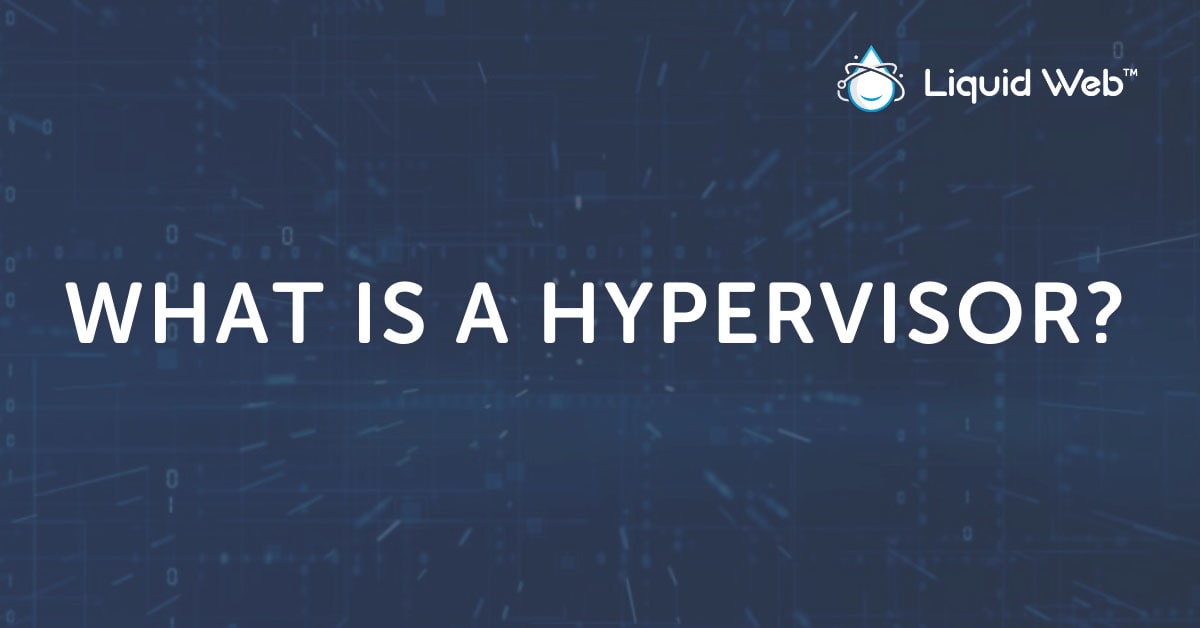
[ad_1]
Invented in the 1960s by IBM for its mainframe computers, a hypervisor is a software layer that allows several operating systems to work alongside one another while sharing the same physical computing resources. These operating systems (OS) function as virtual machines (VMs), which mirror entire computing hardware environments in software layers. Hypervisors are inextricably connected to all virtualization types, as they regulate or supervise the entire virtualization process.
If you’re new to hypervisor technology, this guide is here to help you break it down. Below, we will detail the benefits of hypervisors, how they work, hypervisor types, and provide you with examples.
How Do Hypervisors Work?
Originally referred to as a virtual machine monitor (VMM), a hypervisor allows a host computer to support several guest VMs by virtually sharing its resources. This can include processing power, memory, and storage.
During operation, the hypervisor logically separates each VM from one another and assigns them their own dedicated portion of computing resources. This ensures that the VMs operate smoothly and do not disrupt each other. For example, if one VM crashes or experiences a security breach, the others will remain unaffected.
Hypervisor Types
Hypervisors can be categorized into two main types, including Type 1 (referred to as bare metal virtualization) and Type 2 (referred to as hosted or embedded hypervisors).
Type 1 Hypervisors
A Type 1 hypervisor runs directly on the host computer’s physical hardware.
These hypervisors are typically faster and more efficient than Type 2 hypervisors, as they:
- Interact directly with the host computer’s CPU, RAM, and physical storage space.
- Bypass the need to go through the OS layer.
- Allocate all available hardware processing power and resources to VMs.
- Provide higher security, as there is nothing in between the hypervisor and host CPU that a bad actor could exploit.
Because of these reasons, most enterprise-level organizations opt for Type 1 virtualization for their large-scale, data center computing needs.
Required Hardware for Type 1 Hypervisors
Type 1 hypervisors often require separate management machines or hardware acceleration software to manage multiple VMs and the host computer’s hardware. These hypervisors cannot successfully operate without this technology, as managing VMs and host resources simultaneously is extremely intensive.
Examples of Type 1 Hypervisors
Common examples of Type 1 hypervisors include:
Type 2 Hypervisors
While a Type 1 hypervisor runs directly on the host computer’s physical hardware, a Type 2 hypervisor runs as a software layer on top of the operating system of the host computer.
Robust Type 2 hypervisors typically provide:
- An easy setup process, as they do not require separate management machines.
- Streamlined access to a guest OS alongside the primary OS the host computer runs on, which makes them ideal for end-user productivity.
- Additional toolkits for users to install into the guest OS, which provides enhanced connections between the guest and the host OS.
However, Type 2 hypervisors are not as secure or efficient as Type 1 due to their deployment. Because communication between a Type 2 hypervisor and the host’s hardware must pass through the OS layer, issues such as latency, or a delay in processing requests, can occur.
For this reason, Type 2 virtualization is typically utilized by individual users who need access to multiple operating systems but are not concerned with higher latency, such as engineers who are developing or testing software.
Type 2 hypervisors also introduce greater security risks for the host, as they feature a larger attack surface. For example, if a bad actor gains access to the host OS, they could then compromise any guest OS that is operating within the Type 2 hypervisor.
Required Hardware for Type 2 Hypervisors
Type 2 hypervisors can utilize separate management machines or hardware acceleration software if these features are available and applicable. Typically, Type 2 hypervisors resort to software emulation if the physical host computer cannot provide the required support.
Examples of Type 2 Hypervisors
Common examples of Type 2 hypervisors include:

The Benefits of Hypervisors
Both Type 1 and Type 2 hypervisors feature many benefits, including:
- Efficiency: VMs can be created instantly using hypervisors, which provides organizations with higher accuracy and efficiency when allocating resources for complex workloads.
- Adaptability: Type 1 hypervisors allow guest operating systems and their applications to run on multiple different hardware types, rather than relying on OS-specific devices or drivers. This is because a hypervisor separates each guest OS from the host computer’s hardware.
- Agility: The agility of hypervisors is primarily due to their ability to run multiple VMs using one host computer’s resources—but they also provide agile utilization of physical servers. For example, a hypervisor provides a more cost-efficient way to run multiple VMs, rather than using multiple servers to complete the same task.
- Moveability: VMs in hypervisor software are isolated from the physical host computer, which means they can be moved across multiple servers, if needed. This means IT teams can easily and seamlessly maneuver changing workloads to different localized or remote virtual servers that feature the required networking, memory, storage, or processing capabilities.
The Drawbacks of Hypervisors
While an amazing technology, there are a few concerns with hypervisor environments compared to traditional dedicated servers.
- Resource Overhead: Because hypervisors are the managers of their virtual servers, some of the resources of the physical server will be used by the hypervisor, so the virtual servers will not be able to use 100 percent of the resources of the physical servers.
- Learning Curve: Managing servers in a virtual environment is different from a traditional environment, as you need to learn how to use the hypervisor itself to manage the virtual servers. This can mean additional training for some technicians.
- Additional Security Concerns: Every piece of hardware and software on your server represents a possible attack vector for hackers. Adding virtualization can therefore add security risk through additional attack surface(s).
Hypervisors vs Containers
| Hypervisors | Containers | |
|---|---|---|
| Platform | Full Operating Systems | Independent Applications |
| Structure | Hosted Servers | Hosted Applications |
| Best Uses | Infrastructure or Testing | Application Development |
When it comes to hypervisor virtualization vs containerization, there are a few key differences. Hypervisors are utilized to create and run multiple VMs independently from the host computer’s physical hardware. VMs run complete, independent operating systems and function like any physical computer. A different approach to virtualization uses containers. Containers allow applications to run independently of an OS. Containers run independent applications and borrow resources from the host operating system.
While VMs are typically used to provide infrastructure or full server testing environments, containerization is frequently used to streamline application development and movement.
Hypervisors: A Recap
Hypervisors are essential tools for both organizations and individual PC users, and awareness around them continues to increase as workloads shift to the cloud. They can be used to streamline multiple resource-intensive tasks, such as replicating data, virtualizing desktops, consolidating servers, or supporting private cloud hosting. While they aren’t right in every situation, virtualized servers can solve a host of problems that come with dedicated physical servers.
For example, if an organization uses multiple servers that each provide different services or operating systems, IT teams can have a difficult time managing them all from a central source or platform. With a hypervisor, however, each service or OS can be virtualized, consolidated, and managed from one physical host computer, which streamlines IT workflows and optimizes physical server resources.
Take Your Hypervisor Virtualization Solution One Step Further
The first step to integrating virtualization into your IT infrastructure is often adding a hypervisor to a dedicated (bare metal) server. Liquid Web offers a variety of traditional Dedicated Servers that are perfect for such an implementation.
If you’re ready to scale your digital capabilities and gain even more flexibility from your hypervisor virtualization solution, Liquid Web Cloud Dedicated Servers have you covered.
Integrating the processing power and resources of a traditional dedicated server with the instant provisioning and flexibility of a cloud platform, our Cloud Dedicated Servers allow you to easily build and run multiple task-intensive virtual machines through our hypervisor solution.
If your business is ready for full, enterprise-level virtualization, our Private Cloud Hosting solution can meet your needs. You’ll have full control over a virtual data center that allows you to create virtual machines and infrastructure in whatever combination you need. From high availability databases to load balancing web nodes, our private cloud solution can satisfy the most demanding infrastructure requirements.
Contact us today to start taking advantage of the power of virtualization for all your server hosting needs.
[ad_2]
Source link






